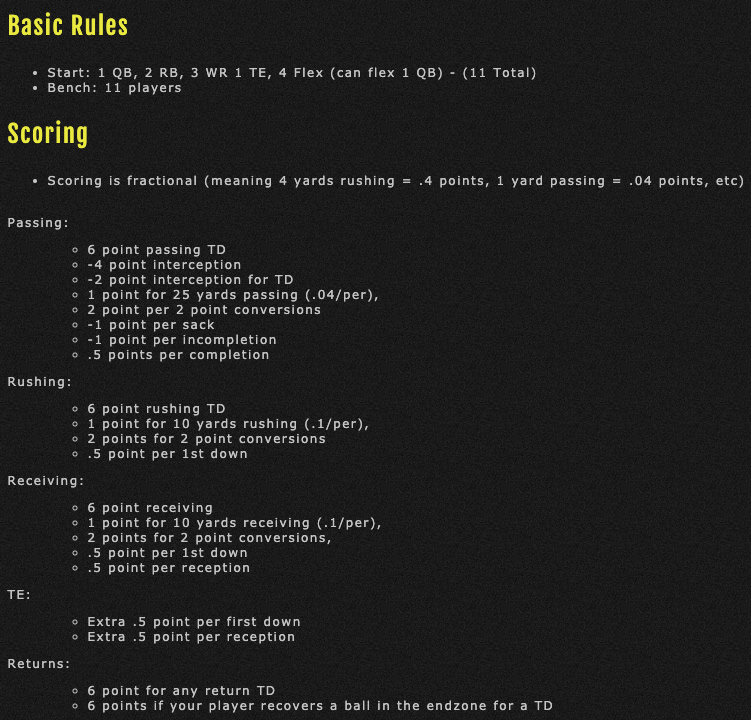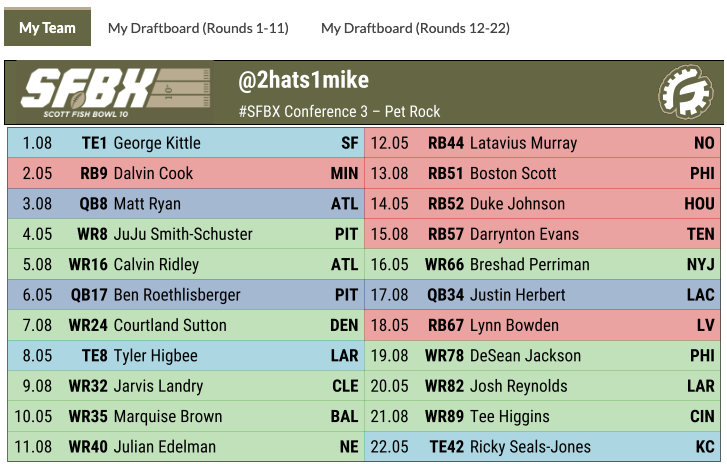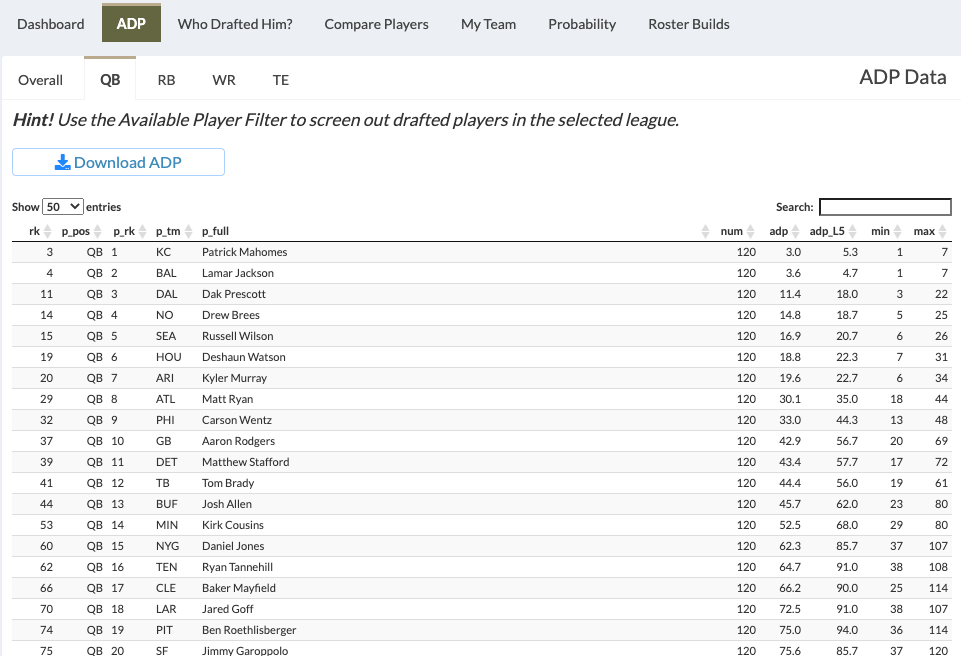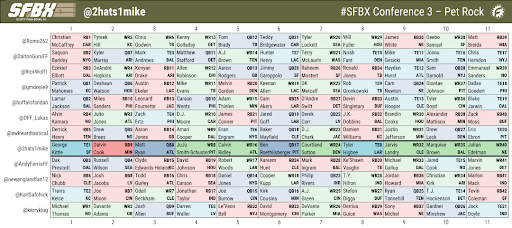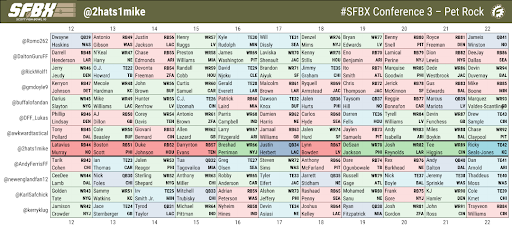We’re nearing the end of that two-week window where the Twittersphere is peppered with Scott Fish Bowl content. If you are unfamiliar with the Scott Fish Bowl, you can read about it here.
With that window coming to a close, I want to share my SFBX (Scott Fish Bowl 10) draft. It’s a unique format, and I’m hopeful my thought process will help people who draft in leagues with unconventional scoring systems and/or deep starting roster positions.
Editor’s Note: The NBA restart is coming and we’re launching a new product led by Drew Dinkmeyer! Click here for more info.
As I mentioned, the SFBX is a unique format, both due to the scoring and roster settings:
There’s a lot to unpack there, but the key takeaways for me right off the bat were:
- You start a lot of guys (9-10 skill players, 3-4 of which are FLEX players), which makes SFBX a “positionless league” to an extent (more on this later)
- TE Premium Scoring
- More or less a 2-QB league
- Passing scoring system favors low INT, high completion percentage QBs much more than in traditional leagues, which helps to close the gap in fantasy value between pure passing QBs and rushing QBs
There are of course other nuances (half point per first down, half point per reception), but after running the math on those elements, they didn’t have a huge impact on my draft strategy.
Here’s the team I drafted out of the 8th spot (images courtesy of Josh Hornsby via his SFBX app on RotoGrinders):
SFBX is Positionless
Right off the bat, you can see this is a modified Zero RB strategy. While I figured I would end up with a roster like this headed into the draft, my goal wasn’t to avoid RBs directly. As I mentioned above, I really tried to view SFBX as a positionless league, outside of the QB position. Assuming a QB in your SUPERFLEX spot, you’re starting 9 skill players a week, a third of which come via the FLEX spots, meaning you can start up to 5 RBs, 6 WRs, or 4 TEs.
In normal leagues, people get way too hung up on having balanced rosters. The importance of balance in deep leagues is particularly overrated. You don’t get bonus points for balance. The scoring system for your RB2 spot is the same as the scoring system for your WR3 spot or for your FLEX3 spot. As a result, I more or less viewed the SFBX skill player spots as FLEX1-9, paying minor attention to the specific positional minimums (and almost none after getting that first starter at each position). After all, you start twice as many FLEX players as you do RBs. So, if my RB2 ends up terrible, well, that’s my FLEX9. Most people are going to have trouble in FLEX9, especially over the course of a season as busts, injuries, and bye weeks occur, meaning you’re quite often reaching 13 or more skill players deep to start several games for you.
In theory, then, I could have just as easily drafted a Robust RB team as a Zero RB team. My goal was to take the skill player with the best combination of median and upside expectations with each pick. It just so happened that due to perceived scarcity and historically fragility of the RB position, the best RB option on my board was rarely equivalent to the best WR/TE options on my board.
NOTE: It’s not that RBs aren’t valuable. In fact, one of the most valuable things in all of fantasy football is hitting on a high end RB finish with a low end RB cost, which is why I gobbled up some of my favorite RB stashes on my bench after building adequate FLEX depth.
Making Assumptions in Large-Field Tournaments
Two other things that may jump out to you about my draft are:
- I took a chance on Dalvin Cook
- I did not take a third QB until late, despite this essentially being a 2-QB league and missing out on elite QBs in the first two rounds
The SFBX structure is a 1,440 team tournament; the specific details of how that happens aren’t that important. When I am drafting in season-long large field tournaments, I like to make certain assumptions about my team throughout the draft. What does that mean exactly?
Well, in a way this is a corollary to balance being overrated. We often try to cover all aspects of team-building when drafting a fantasy team – making sure to get adequate backups everywhere and patch up any parts of our roster that may seem risky. This makes sense, to an extent, especially in regular leagues (10-12 teams, paying out ~ the Top 3 spots). You aren’t going to nail every pick. Busts and injuries happen.
However, it’s hard to maximize your upside when you’re worried about mitigating your risk across your entire roster. So, in formats that reward upside maximization, I like to assume certain things will go right. And if they don’t, I need to accept that I am going to lose (and probably would have anyways). Embracing the likelihood of failure is a feature not a bug.
Assuming Dalvin Cook Does Not Miss Time
Dalvin Cook’s price has dropped from borderline Top 5 pick to a mid-second round pick since news of his holdout. In reality, there’s X% chance Cook misses games or is not in shape or whatever risks are associated with holding out. I’m assuming that X% chance does not hit. This allows me to maximize my upside by taking a Top-5 talent in Round 2. Since I’m assuming Cook hits, I also don’t need to spend a valuable RB stash pick handcuffing him with Alexander Mattison. Why devote two roster spots that max out at one RB hitting, when I can try to parlay Cook and an uncorrelated RB stash into two RBs hitting simultaneously? It also means I don’t have to worry about drafting RBs in particular early because RBs only need to account for 1/8th of my remaining skill starters. And truthfully, if Cook does have a long holdout and busts, I’m likely toast in this format regardless of what I do afterwards. Most people don’t survive a second-round bust in a large-field tournament, no matter how hard they try to build a “safe” roster.
Assuming the QBs Hit
If this format started closer to 6 skill players a week instead of 9, I may have taken a different approach. However, I felt like much of the market in SFBX was accounting for the SUPERFLEX format (advantage in starting 2 QBs each week), but not accounting for how deep the skill players were needed to start each week. In other words, yes starting 2 QBs affects the scarcity of the QB position to a meaningful degree, but heck, starting 9 skill players affects how we should approach the scarcity of the skill position group as a whole as well.
The Assumption I Didn’t Make
You can’t assume everything is going to go correctly, even in large field tournaments. By assuming I got a great RB1 value and that the two somewhat cost friendly QBs I did draft would not get hurt, I was freed up to *not* assume that the WR/TEs I drafted would hit. As a result, I was able to continue to pound WR values while people worried about shoring up other positions and be a round early on some RB stashes when people were taking a backup QB. I took my 8th WR/TE (one more than you can start assuming 2 QB starters) before I took my 2nd RB, and I took my 14th skill player before taking a stab at a 3rd QB.
Someone even quibbled at one point that people who drafted WR early must “HATE” some of the mid-round WR values, to which I responded, “No, we just keep drafting them too:)”.
Dealing With Scoring Quirks
In addition to a unique roster format, the SBX has scoring quirks, most of which I noted above. It can be hard to contextualize how these impact player values. The best way to do it is to have a projections source with statistic details because this lets you account for any scoring quirks without doing any extra work. In lieu of that, though, you can still think through how values may change critically and rely on previous year data to guide you. Here’s how I viewed the three main scoring quirks in SFBX:
TE Premium Scoring
RB and WR score 0.5 points per first down and per reception, but TEs receive a full point per first down and per reception. Obviously, this means all TEs will see an increase in scoring, but we have to be cognizant of two things:
- How a player’s value changers inter-position (relative to players at other positions)
- How a player’s value changes intra-position (relative to players at the same position)
Often times, people make the mistake of only focusing on the first aspect. Admittedly, this dynamic is a little bit less important in SFX since we’re viewing it as “positionless”, but expanding on the point allows you to see where people may make mistakes propping up underserving positions just because that player’s position benefits from scoring quirks.
This TE premium scoring has a rather large impact on the top TEs. For example, last season there were four TEs who recorded 85 or more catches (Travis Kelce, George Kittle, Zach Ertz, and Darren Waller). These TEs averaged 90 catches and 56 first downs. The TE premium bonus means a TE with those statistics scores 72.5 more points than a WR with the same statistics. That’s equivalent to spotting the TE 12 TDs. It’s massive.
However, just as important is the fact that those four TEs continued to expand their positional edge. On average they outscored the 12th scoring TE in half-PPR formats in 2019 by 73 points. With the SFBX scoring, that margin increased to 109 points. The elite TEs see a massive increase in relative scoring both inter-position and intra-position.
Meanwhile, that 12th scoring TE in half-PPR formats (Jason Witten) sees a more muted, albeit still important, increase in inter-position scoring (an extra 45 points to a comparable WR) and in intra-position scoring (an extra 13 points more scored than the TE20 in 2019). In other words, after the high volume TEs, the intra-position edge from TE premium scoring diminishes quickly. This is what often causes the mid-tier TEs, particularly at the back of mid-tier, to be overvalued.
It’s hard to find a direct comparison becasue context is always changing, but Noah Fant and Will Fuller both had ADPs of around 115 in SFBX. If you applied last year’s statistics to SFBX scoring, Noah Fant would see his total points per game rise from 5.7 to 8.4. Will Fuller would see his total points per game rise from 10.0 to 11.2. Clearly, Fant sees a much larger increase due to scoring system, but Fuller is still way more productive. This is a random example taken from the mid-tier, but I think it demonstrates where people could potentially make a mistake.
QB Scoring Changes
UPDATE: A previous version of this article had the scoring for completions and incompletions flipped. This section has been edited to account for that.
Similar to TE, it’s important to understand both the inter-position and intra-position change in value. Interceptions are penalized much more steeply than usual formats (-4), but QBs get a bonus for each completion (0.5), which is offset by a penalty for incomplete passes (-1).
Here’s how I quickly approached the position:
The league average completion percentage last season was 63.5%. That means on average, each pass attempt actually had a slightly negative expectation based on the completion/incompletion scoring alone. As a result, the more pass attempts, the better *only if you’re able to have a completion percentage of 66.7% or higher*. If you have a completion percentage in between that breakeven point and the league average, you’re still in pretty good shape. More attempts will impact your fantasy point total slightly negatively, but other QBs with lower completion percentages will be penalized harsher per attempt. I ended up with Matt Ryan (led the league with 408 completions last season; 66.2 and 69.4 completion percentage the past two seasons) and Ben Roethlisberger (led the league in completions and attempts in 2018 while completing 67% of his passes).
On the whole, the market was keen to the QB scoring, pushing up guys above their usual 2-QB ADP who benefitted from the scoring (Drew Brees), and pushing down guys below their usual 2-QB ADP who were hurt, accounting for the change in intra-position value (Josh Allen, Daniel Jones):
In addition to the QBs I selected, Jared Goff seems to be undervalued (led league in pass attempts last season, career 62.5 completion%, 7.6 YPA, and 4.7 TD%), especially if he can boost his completion percentage back to 2018 levels (64.9%).
First Downs
This was the scoring quirk I paid least attention to, as noted in the outset. I think the market may have overvalued the impact here on RBs.
The Top-10 WRs in half-PPR scoring last season averaged 204 fantasy points on the season. If you factor in first down scoring, that rises to 233 points. The Top-10 RBs in half-PPR scoring last season averaged 271 points, If you factor in first down scoring, that rises to 311 points. In other words, the Top-10 WRs saw a 14.2% increase in their scoring output, and the Top-10 RBs saw a 14.8% increase. Anecdotally, increased first downs would seem to favor RBs, and using raw totals may support that. However, the percentage increase (which is all we care about) isn’t divergent enough for this to alter my draft strategy.
Perhaps it makes a bigger difference in the mid-tier? If we compare an RB3 (RB25-RB36) to a WR3 (WR25-WR36), we see this is somewhat the case. The WR3s averaged 158 fantasy points, rising to 178 fantasy points with first downs included (12.7% increase). The RB3s averaged 138 fantasy points, rising to 161 fantasy points with first downs included (16.7%) increase). So, roughly for every 150 half-ppr fantasy points scored, RB3s achieved a 6-point relative edge on WR3s (25 fantasy points from first downs compared to 19). It’s not nothing, but it’s a small edge for such a high scoring format, especially when A) the market is overrating its impact and B) you’re trying to think probabilistically and in terms of range of outcomes, not in getting pinned down on an extra 6 points of a median projection.
If your league uses first downs in their fantasy scoring, I found this website to be a useful resource:
Other Notes
Stacking
Earlier this offseason, I wrote about the power of Stacking in Season-Long and identified some Stacking Targets. I did not get the double stacks I had hoped for in this draft, but I was able to pair high upside WRs (Juju Smith-Schuster, Calvin Ridley) with their QBs (Ben Roethlisberger, Matt Ryan) without paying much of a premium. I arguably should have made a bigger effort to add a second passing game option to each of those stacks. I had opportunities to draft Diontae Johnson and Hayden Hurst, but the market seems to be way higher on those players than I am. It can be difficult to balance structural drafting with micro player analysis.
Scarcity as a Tiebreaker
Based on the league format or the people you play with, you may have an inkling of how your leaguemates will allocate their resources, and you should use that to your advantage. As noted in the scoring quirks section, I was pretty sure the TE Premium scoring would cause people to overrate some of the mid-tier or later TEs, something Adam Levitan and I discussed in our FFPC strategy podcast. As a result, when I was up with the 8th overall pick, I selected George Kittle over Michael Thomas and the second tier of QBs. I had all of them ranked similarly, but thinking mid-tier TEs might be overvalued, I selected Kittle. Better to take a TE at breakeven value early rather than pay a premium at the position later.
Similarly, I took Tyler Higbee in Round 8. He’s a player that the market is generally higher than me on. At that point, though, I locked in the ADP value and got a second TE, once again guessing that the TEs following him may be overdrafted. Sure enough, Rob Gronkowski, Noah Fant, Mike Gesicki, Hayden Hurst, and Austin Hooper all went before my 9th round pick, allowing me to get the WR I was initially targeting in Round 8 anyways. 8 more TEs were drafted in Rounds 10-11.
DRAFT BOARD
Rounds 1 – 11
Rounds 12 – 22

